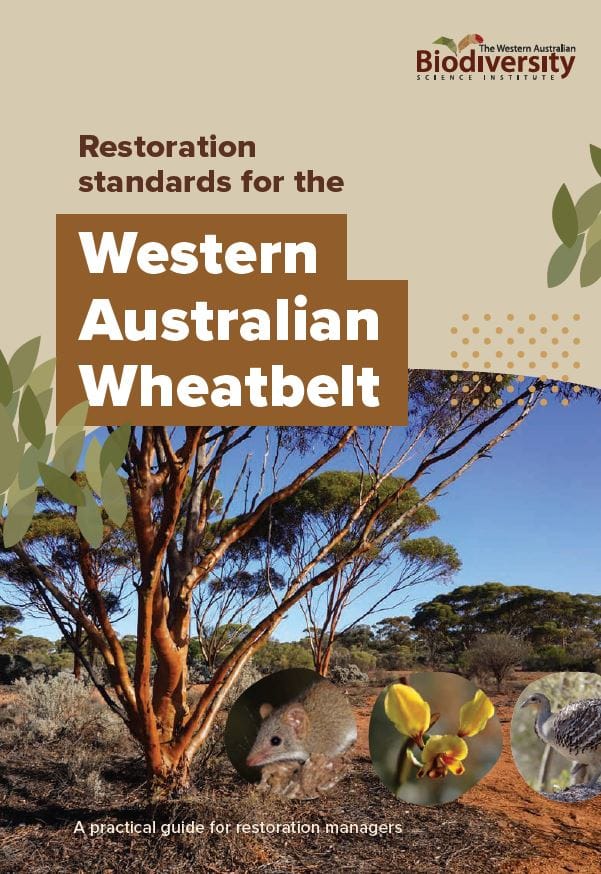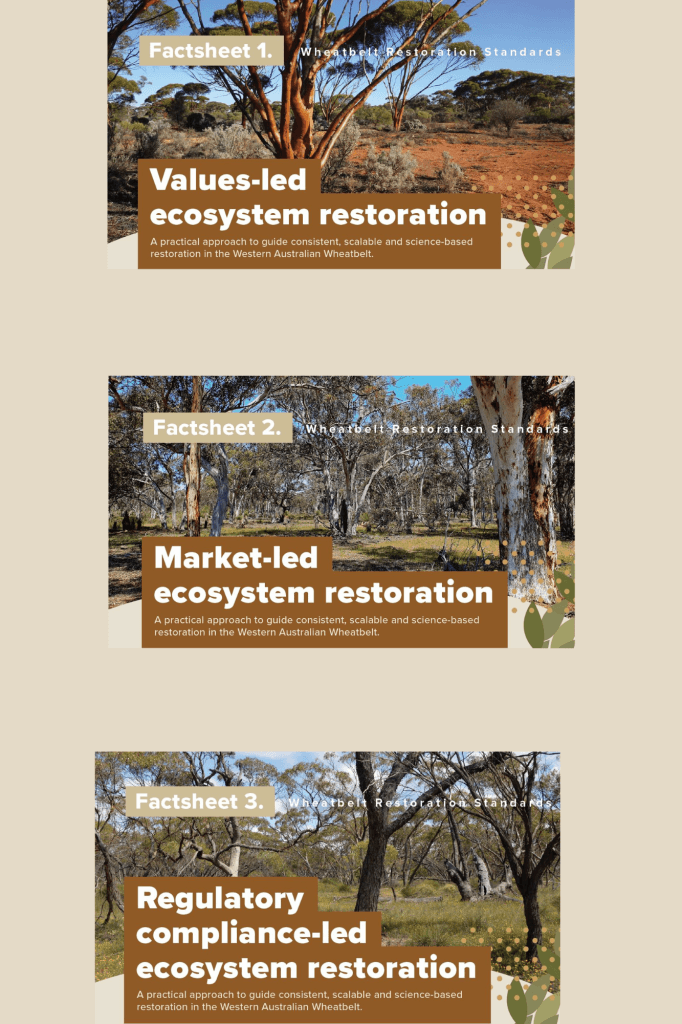Restoration standards for the Western Australian Wheatbelt – A practical guide for restoration managers
The Wheatbelt region of the south-west of Western Australia is one of the most cleared and fragmented, ancient landscapes in Australia. The region is recognised as a globally significant biodiversity hotspot and for its exposure to a diverse range of threats including climate-induced drying. Multi-purpose restoration activities in pursuit of practical repair of degraded ecosystems, nature conservation, and nature positive goals are driving land use change across significant areas in the Wheatbelt. The developing restoration economy provides an investment framework supported by governments to protect and restore nature.
Ecosystem restoration that aims to establish either endemic native ecosystems or novel communities may be subject to complex challenges throughout the life of a project. The Wheatbelt Restoration Standard presents a linear framework, principles and tools to guide on-ground ecosystem restoration practice. It recognises all restoration efforts are intrinsically linked to long-term social-ecological outcomes for the region.
A shared understanding of restoring resilient ecosystems is fundamental to achieving effective landscape-scale restoration outcomes for the Wheatbelt region. Adopting a consistent, repeatable and scalable approach to restoration enables synergistic interactions within environmental systems and land use. Standardised restoration-related information can contribute to improved environmental outcomes for the region through innovation, collaboration and research.
Project approach – Driven by the needs of end users
In 2022, WABSI hosted a workshop that brought together stakeholders from government, industry and research, to identify gaps and barriers to advancing strategic restoration priorities within the Wheatbelt. Following further consultation with stakeholders, a program scope was developed to initiate the Wheatbelt Restoration Standard, commissioned in 2023 and commenced in 2024.
Local, national, and international literature was reviewed, and interviews undertaken with Noongar kaartdijin (knowledge) holders, stakeholders in restoration ecology science, climate science, natural resource management, agriculture, government and industry to understand the needs and benefits of restoration activities, current barriers and priorities for the Wheatbelt. Following the WABSI program delivery model, the standards were developed in an iterative approach with ongoing engagement between stakeholders and experts to refine the framework and tools.
Project partners: CBH, Department of Biodiversity, Conservation and Attractions
Project outputs

Practical tools and checklists
- Ecological Recovery and Social Benefits Wheels – The Society for Ecological Restoration’s wheels for the development of detailed monitoring, evaluation and reporting of projects and for developing performance indicators for social, environmental and economic values important to stakeholder and partners of a restoration project
- WWTEC tool – An online workbook for use by restoration managers for a variety of purposes including selecting species that are suited to landforms and soil characteristics of a project site and developing planting designs analogous to the composition and structure of eucalypt communities and subcommunities comprising Eucalypt Woodlands of the Western Australian Wheatbelt Threatened Ecological Community (WWTEC) Click here to access this tool
- Example completion criteria – A guide for the development of specific completion criteria required under regulatory environmental approval process
- Polarity tool – To guide decision-making against target values when planning and implementing a restoration project
- Restoration barriers and enablers checklist – A starting point to consider factors that may be relevant to a project
- TAS cost model and CF-LRP costings calculator – A starting point for restoration managers to assist with developing budget inputs, assumptions, resource requirements and the availability of expertise, with the habitat restoration threat abatement strategy (TAS) cost model and the WA Government Carbon Farming and Land Restoration Project (CF-LRP) costing calculators
- EMSA field data templates – Resources for use when implementing a restoration plan, including capturing site assessment and monitoring information. The Terrestrial Ecosystems Monitoring Network (TERN) ecological field monitoring protocols (EMSA 2024) provide standardised data collection templates and methods, together with a field data collection app digitising data templates
Factsheets for quick reference
- Factsheet 1 – Values-led ecosystem restoration
- Factsheet 2 – Market-led ecosystem restoration
- Factsheet 3 – Regulatory compliance-led ecosystem restoration

Want to know more? Contact us restoration@wabsi.org.au